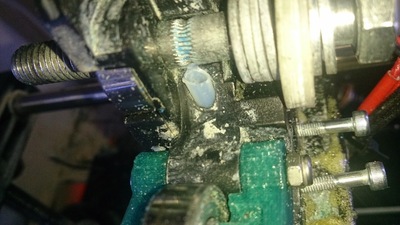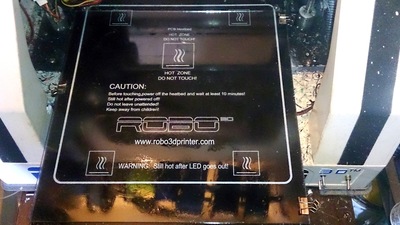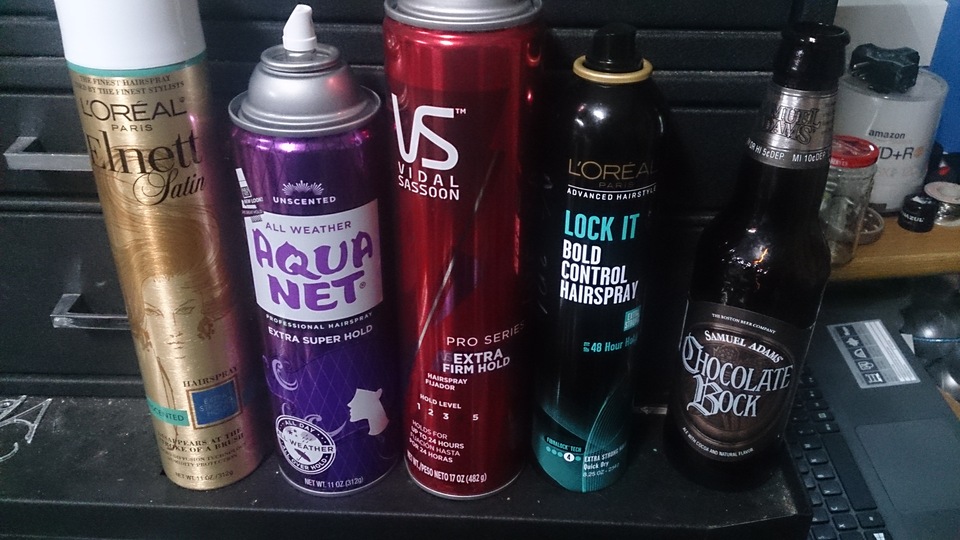With the stock Robo3D, there is a large gap between the hobbed bolt and the bottom; this causes some issue with normal ABS (PLA is usually stiff enough) and makes Flex almost impossible to use (maybe usable at 1/4 speed, but if you see a z-kink when you're done, you know you've gone too fast).
Some people suggest using a ferrule from a mechanical pencil to cover the gap, but I think I did one better -- I put a PTFE tube from the hobbed bolt all the way down to the top of the hotend (for those with an E3Dv6, I'd recommend removing the PTFE tube from it and making a single extension all the way down:

PTFE Support Tube, bearing removed for clarity. I need to clean the bolt again...
- Remove hotend, release the idler pulley, and remove the hobbed bolt - this should leave nice access to the filament path.
- Remove any fittings from the top of the hotend, and if you can feed the new PTFE tube into the hotend (eg, E3Dv6, but not the original Robo3D), remove the PTFE tube from the hotend; measure this and add 3" to that -- this is the starting length of the your new PTFE tube.
- Cut a new piece of PTFE tubing to the length necessary to go from the hobbed bolt until it bottoms out in the hotend. Too long doesn't matter.
- Sharpen one end of the PTFE tubing with a manual pencil sharpener, just to put a bevel on it (I should work out a better way of aligning this, but this works very well).
- Bore out the plastic-path with a 5/32 drill bit (this part was easy for me because I had a right-angle drill) -- Don't hit the print bed.
- Blow out the dust.
- Feed a length of PLA through (in order)
- PTFE tubing
- Filament Path of extruder
- Hotend (hotend should be cold... this is just for alignment purposes.
- Push the PTFE tubing down through the Filament Path until it comes clearly out the bottom and you can put it into the hotend; bottom it out in the hotend (this is a bit hard-- I made it a tight fit so I didn't have to worry about the PTFE tube migrating up into the hobbed bolt on retracts).
- Push the hotend (with PTFE and filament) back into position - this should make a length stick out where the hobbed bolt goes.
- Secure the hotend in place; the PTFE tubing should still be bottomed out in it.
- Pull PLA out, and trim the PTFE tube so you can put the hobbed bolt in.
- Close the mechanism gently, and continue trimming the PTFE tube with a razor blade until the idler doesn't squish the PTFE tube -- make the cut match the angle of the idler if possible. Don't let the scrap fall into the tube.
- You probably don't have to, but you can remove the hobbed bolt, and bore the PTFE tube with a countersink bit just a bit to make a funnel shape to make it easier to load the filament; if you do this, you have to disassemble and then do steps 6-10 again to make sure you don't get PTFE dust in your hotend (that will cause clogs).
With this, there's almost no dead-space between the feed rollers of the extruder and the PTFE support tube, so even flex won't kink up in it. You might have to cut the filament at a 45 angle if you didn't use a pencil sharpener in step 4.
After you do this, you might want to use a PLA "guide" whenever you remove and reinstall the hotend to make sure it stays aligned when reinstalling the hotend (or you have to use a 45 degree filament cut).
Should I make an Instructable out of this? Then the pictures would be a little more meaningful...
-Thor



